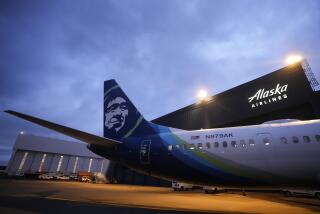NTSB Crash Report Cites Inadequate Space Between Jets : Aviation: Board says Santa Ana tragedy could have been prevented if the Westwind pilot or air-traffic controllers kept an âadequateâ cushion behind Boeing 757.
Stopping short of casting blame, a federal report released in Washington on Thursday suggests that a Dec. 15 fatal plane crash in Santa Ana may have been prevented if the pilot or air-traffic controllers had kept an âadequateâ safety cushion between the aircraft and a Boeing 757 jetliner landing ahead of it.
The report by the National Transportation Safety Board focused on the hazards posed by wake turbulence created by 757s and underscored a series of recommendations adopted by the NTSB last month.
Although a separate report on the Santa Ana crash will be forthcoming, Thursdayâs document cited the accident a number of times as the NTSB continues to pressure the Federal Aviation Administration to enact changes designed to prevent accidents caused by 757 wake turbulence.
The NTSB, which does not have regulatory power, has made 19 safety recommendations involving 757s to the FAA, among them, that the agency lengthen the minimum distances between aircraft landing behind 757s.
NTSB records show that there were 51 instances of aircraft caught in wake turbulence over the last decade, resulting in the deaths of 27 people and damage-destruction of 40 airplanes. The NTSB found that a disproportionate number of incidents--five since December, 1992, resulting in 13 deaths--involved wake turbulence from 757s.
The accident in Santa Ana occurred when a twin-engine Westwind corporate jet was on approach to John Wayne Airport. The jet, which was 2.1 miles behind a 757, went out of control and slammed nose-first into the ground near the Santa Ana Auto Mall. All five aboard, including the top two executives of the In-N-Out Burger chain, were killed.
In part because of the Santa Ana accident, the NTSB unanimously recommended Feb. 15 that similarly sized corporate jets be kept five miles behind 757s on final approach.
The Santa Ana accident remains under investigation by the NTSB, but the report released Thursday provides the first clues as to what aviation safety officials believe was the cause of the crash and how it might have been prevented.
âThe only way the pilot of the Westwind could have maintained adequate separation was to execute significant maneuvers,â the report says.
Similarly, the report says that âto prevent compromise of the separation requirement, the controller would have had to take positive action to change the Westwindâs track.â
Although the NTSB does not consider the 757 to have any design flaws, researchers have speculated that its unique, sleek-wing design may be the cause of turbulence that is unusually powerful for an aircraft of its size.
More to Read
Inside the business of entertainment
The Wide Shot brings you news, analysis and insights on everything from streaming wars to production â and what it all means for the future.
You may occasionally receive promotional content from the Los Angeles Times.










